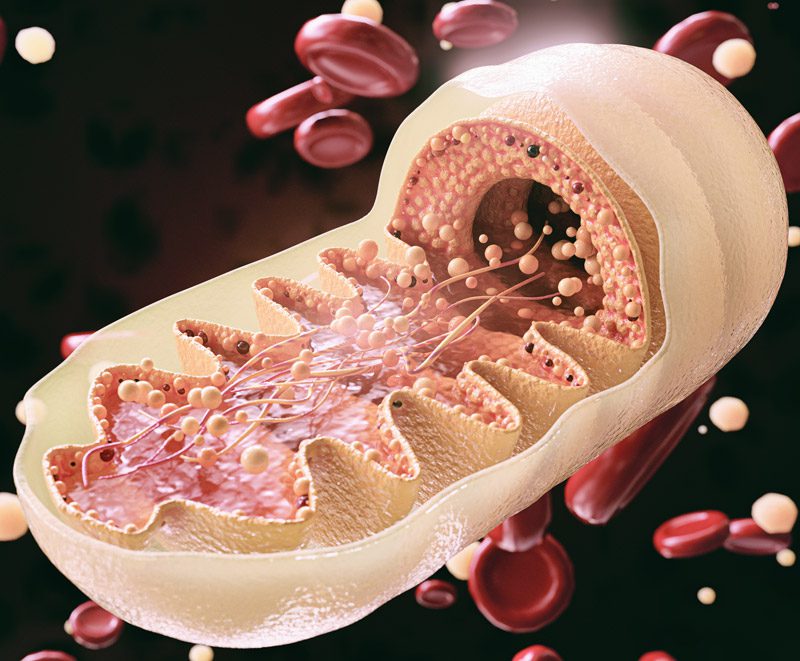Mitochondrial Function
Mitochondria has a significant function in breaking down nutrients as well as creating energy-rich molecules for the cell.
Mitochondrial Functions
Although the most widely-known function of the mitochondria is their energy production, you can find a wide range of other crucial tasks too. In fact, just about 3.5% of genes required for the creation of a mitochondrion are put to its energy-producing equipment. A majority of them contribute to different tasks specific to the type of cell in which they retain themselves.
Mitochondria are organelles that have membranes. Enclosed by the cell membrane, they reside in the thick solution that fills each cell in all eukaryotic cells. These produce adenosine-triphosphate (ATP), a primary energy molecule used by cells. Often referred to as the “Powerhouse of the cell,” you can call mitochondria as membrane-bound double organelle found in the majority of living organisms. They mainly help in the “digestive systems” of cells.
The word “Mitochondrion” originated from the Greek words “mitos” and “chondrion,” which is a reference to “thread” as well as “granules-like.” Richard Altmann, a German pathologist, first discovered it in the year 1890.
Mitochondria has a significant function in breaking down nutrients as well as creating energy-rich molecules for the cell. In mitochondria, you will find a large number of biochemical reactions carried out associated with cell respiration.
Mitochondria Structure
You will find that mitochondria maximize their effectiveness with its perfect shape. Made up of two separate membranes, the outer membrane works as a protective layer over the organelle. It encases it as skin. The inner membrane folds several times, creating layers of structures known as Cristae. Further, the mitochondria contain a liquid known as the matrix.
A fold in the membrane’s inner layer increases the area of the organelle. Since a lot of chemical reactions take place within the membrane, the increased surface area allows more room for the reactions to take place. When you’ve got more room to work from, you’ll be able to accomplish more tasks. Your digestive tract has microvilli that use similar strategies for surface area.
Now, what’s inside the matrix? Mitochondria are distinct because they possess their own. This is due to the fact that they have ribosomes with DNA floating within the matrix. Additionally, it has structures known as granules that can control the concentration of ions. Cell biologists are currently studying the function of granules.


Let’s Look at a Few Mitochondrial Functions in Detail.
Energy Production
As referenced above, you can call ATP a complex organic chemical found in all living things. Commonly called the molecular unit, it powers due to its ability to push metabolic processes. Mitochondria lead to a sequence of chemical reactions to create most of the ATP, known as citric acid cycles or the Krebs cycle.
The majority of energy production occurs within the folds or cristae on the inner membrane.
Mitochondria transform chemical energy from the food we consume into energy that the cells can use. You can call this whole process as oxidative phosphorylation.
The Krebs cycle creates an organic compound called NADH. The enzymes utilize the NADH embedded in the cristae to create ATP. Chemical bonds, in the form of energy, form inside the molecules of ATP. These bonds break and release energy for utilization whenever necessary.
Cell Death
Cell death, known as Apoptosis, is a vital element that plays a major role in keeping us alive. Mitochondria determine the cells to destroy. It kills the ones who have aged or have become damaged.
Mitochondria release Cytochrome C that activates caspase, one of the principal enzymes involved in the destruction of cells in the process of Apoptosis.
Since certain illnesses like cancer cause a disruption in normal Apoptosis. Mitochondria are believed to be involved here too.
Storing Calcium
The mineral calcium is essential for many cellular processes. For instance, the release of calcium back into cells could trigger the release of neurotransmitters from the nerve cell, or
release hormones from the endocrine cell. Calcium is also essential in muscle as well as fertilization and blood clotting, among others.
Since calcium is so crucial, the cell regulates it with great care. Certainly, mitochondria play a role in this process. It rapidly absorbs calcium ions and holds them until required.
Other roles of calcium in cells include controlling cellular metabolic processes, steroid synthesis as well as the signaling of hormones.
Production Of Heat
When we’re cold, we tend to shiver in order to stay warm. However, the body is able to produce heat in different ways. One way is through the use of brown fat, a type of tissue. In a process known as proton leak, mitochondria produce heat. This process refers as thermogenesis. Brown fat is present in the highest concentrations in newborns, which is when we are most susceptible to cold. However, slowly levels decrease as we get older.


Mitochondria And Aging
In the past few years, researchers have been studying the connection between mitochondrial dysfunction and aging. There are many theories on aging, and the idea of mitochondrial free radicals as a cause for aging has been popular in the last 10 years.
The hypothesis suggests that reactive oxygen species (ROS) form inside mitochondria as a product of energy generation. These highly charged particles harm DNA as well as fats and proteins, further damaging mitochondria.
Mitochondria’s dysfunctional ability causes the creation of further ROS, thereby making a loop.
While correlations between mitochondrial activity and aging have been observed, however, not all researchers have come to the same conclusion. The precise role they play in the process of aging remains a mystery.
Utilizing Oxygen to Release Energy
The next question is – What is the process of cellular respiration in mitochondria? The matrix is filled with water as well as protein (enzymes). These proteins absorb organic molecules, including acetyl and pyruvate, CoA. It then experiences a chemical breakdown. Proteins
embedded in the membrane as well as enzymes that are involved with the citric acid process eventually discharge the water (H2O) as well as carbon dioxide (CO2) molecules due to the decomposition of oxygen (O2) and glucose (C6H12O6). Mitochondria are the sole cell organelles where oxygen is depleted and later is broken down into the water.
Mitochondria are involved in regulating the level of calcium (Ca2+) in the cell. They are closely linked to the endoplasmic reticulum in order to limit the amount of calcium that is present in the cell’s cytosol.
Takeaway
Mitochondria are likely the most well-known organelle. Often referred to as the cell’s powerhouse, they perform various activities. From the storage of calcium to the generation of heat, mitochondria are vital in our cells’ daily activities. Want to preserve the best of mitochondrial functions in the body? Visit Siorai today
